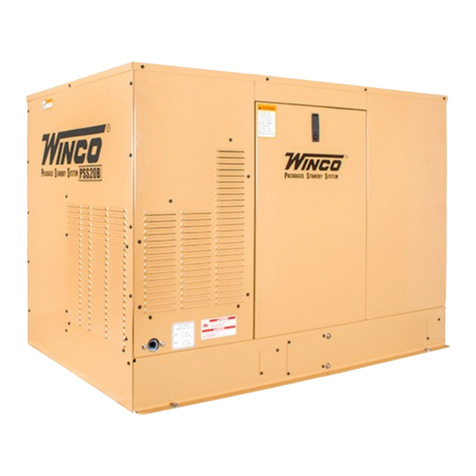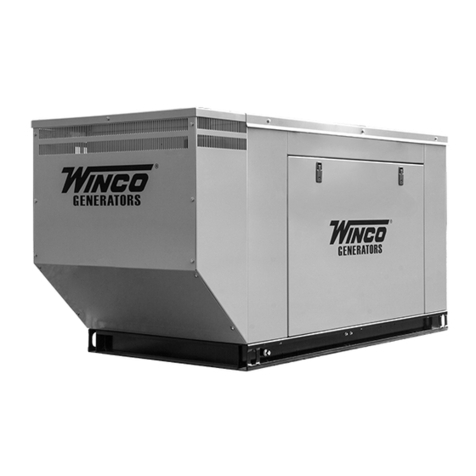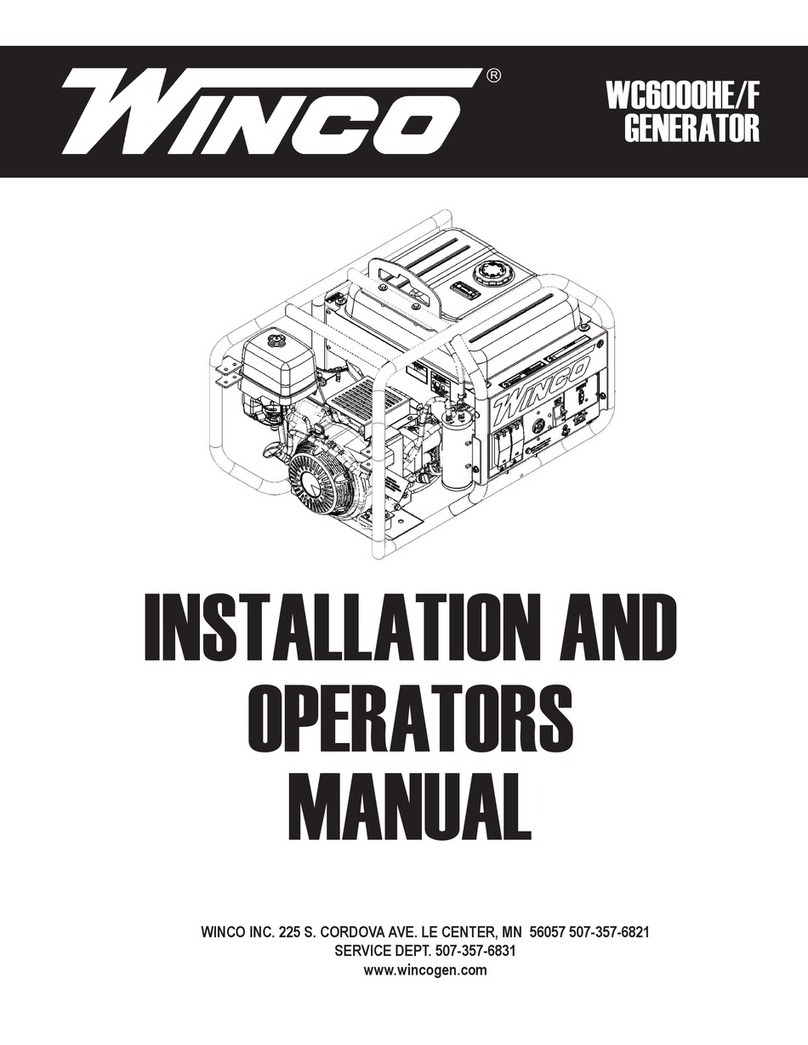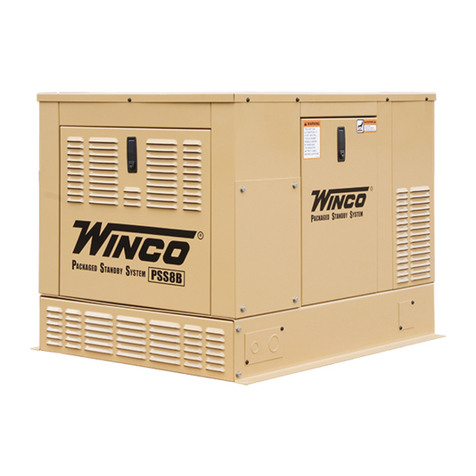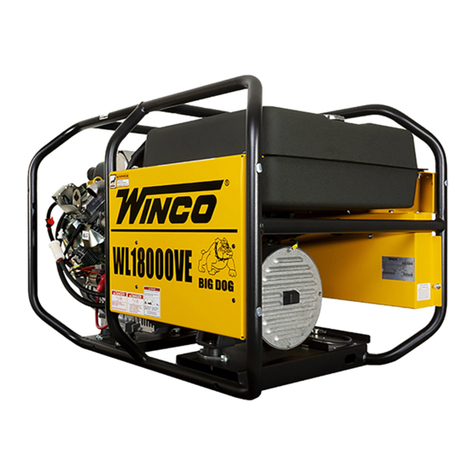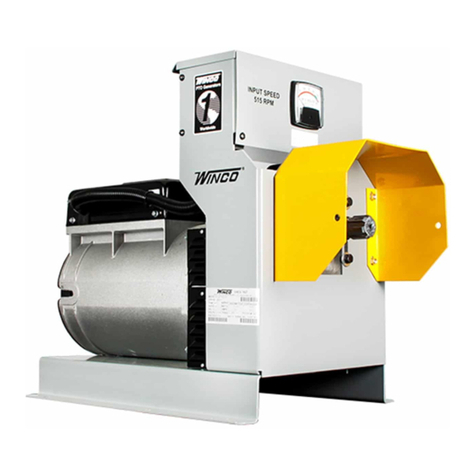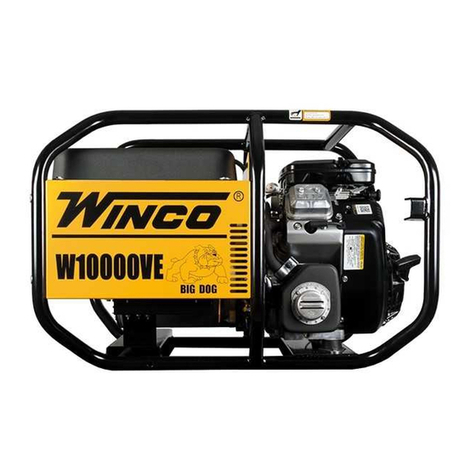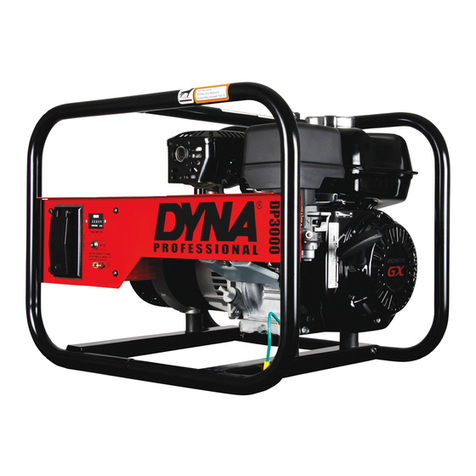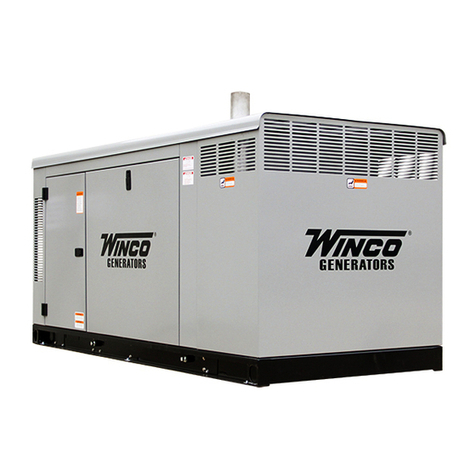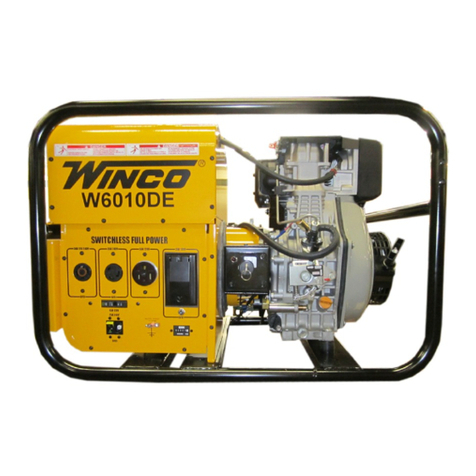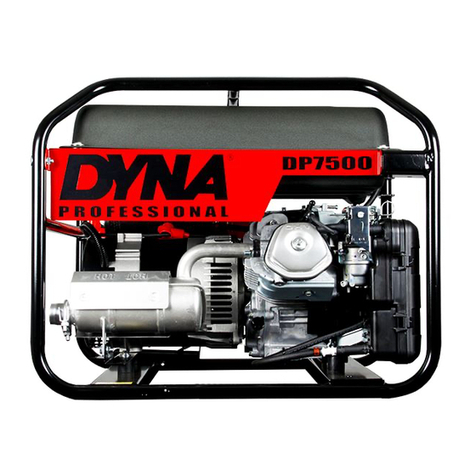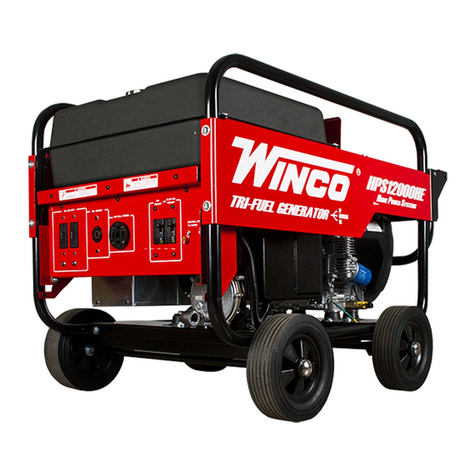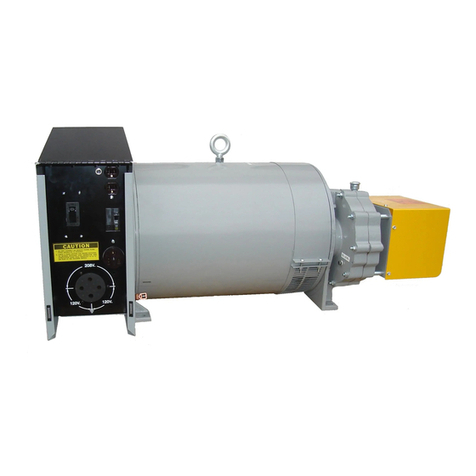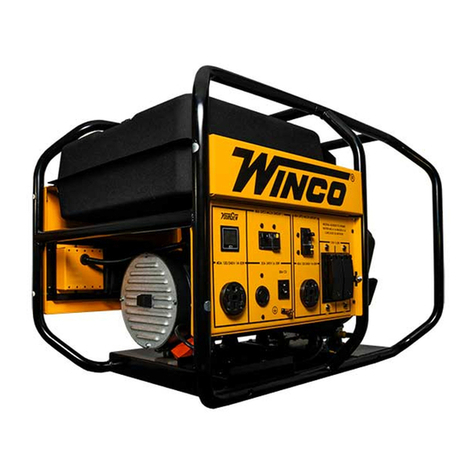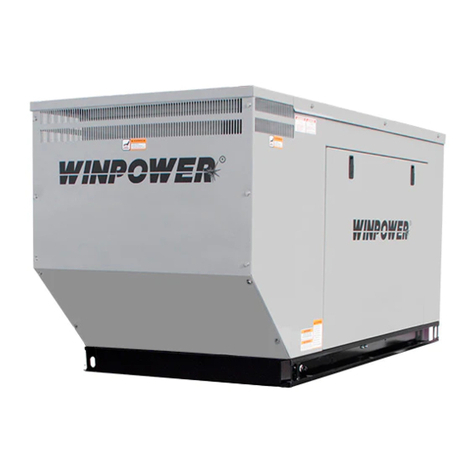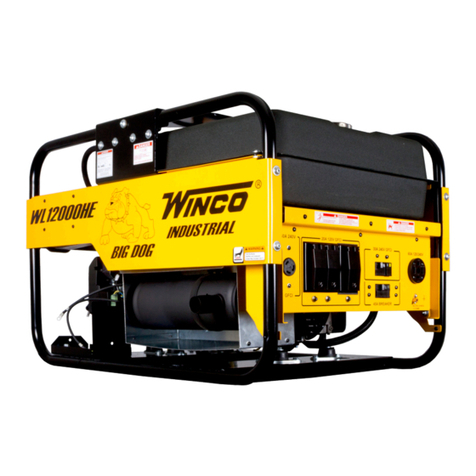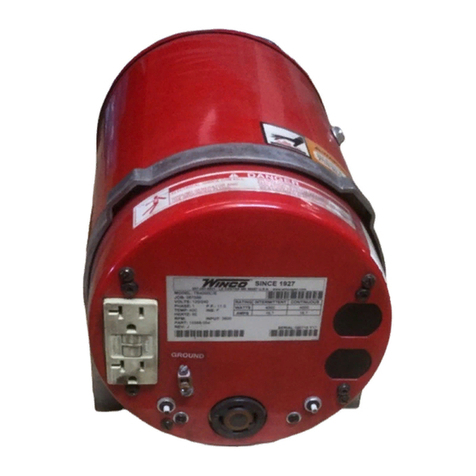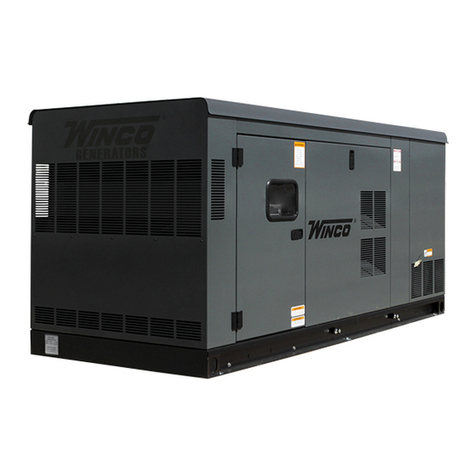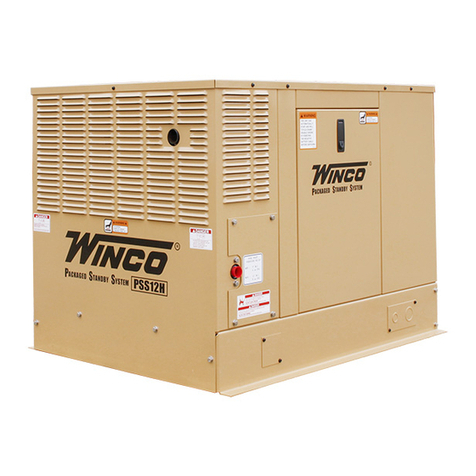
6
OPM-138/B
Oil is added to the engine by removing the oil cap and
adding oil at this point. After filling the crankcase to the
proper level, be sure you properly tighten the oil fill cap (‘C’).
NOTE: This engine generator must be on a level surface
before you check or add oil to the system.
The necessity of using the correct oil and keeping the
crankcase full cannot be overemphasized. Engine failures
resulting from inadequate or improper lubricant are
considered abuse and not covered by the generator or
engine manufacturer’s warranty.
OIL RECOMMENDATIONS
Outdoor temperatures determine the proper oil viscosity for
the engines. Use the chart to select the best viscosity for the
outdoor temperature range expected.
OIL ALERT SYSTEM
This generator is equipped with a low oil shutdown system.
This Briggs & Stratton engine uses an oil pressure switch
system. If the oil level drops below a certain point the low
oil module on the engine will shut it down. This low oil
warning system will automatically stop the engine before
the oil level reaches critical danger point. This feature is
designed to prevent costly repairs and downtime.
CAUTION: EQUIPMENT DAMAGE
Allowing the engine to shutdown repeatedly on low oil
level may cause excessive wear which can be cumulative.
GASOLINE
When using gasoline, always use fresh, clean, unleaded
fuel. The engine is certified to operate on unleaded gasoline
with a minimum octane rating of 87 or higher. Gasoline
containing no more the 10% ethanol is acceptable.
CAUTION: EQUIPMENT DAMAGE
Do not use unapproved gasolines, such as E15 or E85.
Do not mix oil in the gasoline. Use of unapproved fuels
will damage the engine compenents and void the engine
warranty.
5
3110-00 60706-239
Self-exciting generators respond to severe overload-
ing differently than utility power. When overloaded,
the engine is not able to supply enough power to
bring the electric motor up to operating speed. The
generator responds with high initial starting current,
but the engine speed drops sharply. The overload
may stall the engine. If allowed to operate at very low
speeds, the electric motor starting winding will burn
out in a short time. The generator winding might also
be damaged.
CAUTION: EQUIPMENT DAMAGE
RUNNING THE GENERATOR SET UNDER
THESE CONDITIONS MAY RESULT IN DAMAGE
TO THE GENERATOR STATOR AS WELL AS THE
MOTOR WINDING.
The heavy surge of current required for starting mo-
tors is required for only an instant. The generator will
not be damaged if it can bring the motor up to speed
in a few seconds of time. If difficulty is experienced in
starting motors, turn all other electrical loads off and if
possible reduce the load on the electric motor.
PREPARING THE UNIT
UNPACKING
CAUTION: EQUIPMENT DAMAGE
THIS UNIT HAS BEEN SHIPPED WITHOUT OIL.
Failure to maintain the engine oil at the proper level
will result in serious engine damage.
When you unpack your new engine-generator set be
sure to remove all the information sheets and manu-
als from the carton.
1. This generator-set was in good order when
shipped. Inspect the generator-set promptly after
receiving it. If any damage is noted, notify the trans-
portation company immediately; request proper pro-
cedures for filing a “concealed damage” claim. Title
to the equipment and responsibility for filing a claim
rests with you when a generator-set is sent F.O.B.
shipping point. Only you can legally file a claim.
2. Before proceeding with the preparations of your
new generator-set for operation, take a couple of
minutes to insure the unit you have received is the
correct model and review the specification pages in
this manual to insure that this unit meets your job
requirements.
LUBRICATION
Before starting the engine, fill the crankcase to the
proper level with a good quality oil. The recommend-
ed grade of oil and quantity of oil required is listed in
the engine operator’s manual and under the service
tab in this manual. This unit was shipped with most
of the oil removed. The engine normally holds 2.4 to
2.5 quarts of oil. Since there is some trapped oil in
the engine, when filling the crankcase the first time
use the dipstick (ref “A”) to ensure that you do not
over fill the crankcase. Reference “B” shows the full
oil level mark on the dipstick.
Oil is added to the engine by removing the oil fill cap
(ref “C”) and adding oil at this point. After filling the
crankcase to the proper level, be sure you properly
tighten the oil fill cap. NOTE: This engine generator
must be on a level surface before you check or add
oil to the system.
The necessity of using the correct oil, and keep-
ing the crankcase full cannot be overemphasized.
Engine failures resulting from inadequate or improper
lubricant are considered abuse and not covered by
the generator or engine manufacturer’s warranty.
Oil Recommendations
Outdoor temperatures determine the proper oil vis-
cosity for the engines. Use the chart to select the best
viscosity for the outdoor temperature range expected.
A
C
A
B
SAE 30
10W-30
Synthetic 5W-30
5W-30
°F°C
Use of fuels with content of ethanol greater than shown
above may cause starting and/or performance problems.
Always ensure that the fuel is clean and free of all
impurities.
WARNING: FIRE DANGER
Gasoline and its fumes are VERY explosive when proper
precautions are not taken.
Never use gasoline that has been stored for an extended
period of time as the fuel will lose its volatile properties
and you will be left with varnish residue. The varnish
like substance will clog the carburetor and will not burn
properly.
The use of fuel additives, such as Sta-Bil, or an equivalent
will minimize the formation of fuel gum deposits. If a unit
has been out of operation for an extended period of time,
it is best to drain old fuel from the engine and replace with
fresh fuel before attempting to start.
See the engine manual for special instruction for operating
this unit at over 5000 feet.
BATTERY INSTALLATION
This engine generator set is shipped with a battery tie down
kit for customer installation. This kit consists of a battery
tie down and hardware for installation of the customer
supplied battery on the unit.
If you intend to use the power plant’s electric start system,
you will need to purchase and install a battery to operate it.
A 12 Volt battery, group 26 rated at 500 CCA or larger is
recommended for this electric start engine-generator set.
Follow the battery manufacturers recommendations for
servicing and charging prior to use. Connect the battery to
the electric start system using the cables provided.
CAUTION: EQUIPMENT DAMAGE
These electric start engines are NEGATIVE GROUND. Use
extreme caution when connecting the battery. Connect the
NEGATIVE battery terminal to GROUND.
For your safety, always connect the positive battery cable to
the “bat+” terminal first. Then connect the negative battery
cable to the “bat-” terminal. Make sure all connections are
clean an tight. Reverse the sequence when disconnecting,
disconnect the negative cable first. These engines produce
3110-00 660706-239
* Below 40OF (4OC) the use of SAE30 will result in
hard starting.
** Above 80OF (27OC) the use of 10W-30 may cause
increased oil consumption. Check oil level more
frequently.
Briggs & Stratton recommends the use of their war-
ranty certified oils for best performance. Other high-
quality detergent oils are acceptable if classified for
service SF, SG, SH SJ or higher. Do not use special
additives.
GASOLINE
When using gasoline, always use fresh, clean,
unleaded fuel. This engine is certified to operate on
unleaded gasoline with a minimum octane rating of
87 or higher. Gasoline containing no more than 10%
ethanol is acceptable.
CAUTION: EQUIPMENT DAMAGE
Do not use unapproved gasolines, such as E15 or
E85. Do not mix oil in the gasoline. Use of unap-
proved fuels will damage the engine components
and void the engine warranty.
Use of fuels with content of ethanol greater than
shown above may cause starting and/or perfor-
mance problems. Always insure that the fuel is
clean and free of all impurities.
WARNING: FIRE DANGER
Gasoline and its fumes are VERY explosive when
proper precautions are not taken.
Never use gasoline that has been stored for an ex-
tended period of time as the fuel will lose its volatile
properties and you will be left with varnish residue.
The varnish like substance will clog the carburetor
and will not burn properly.
The use of fuel additives, such as STA-BIL, or an
equivalent will minimize the formation of fuel gum
deposits. If a unit has been out of operation for an
extended period of time, it is best to drain old fuel
from the engine and replace with fresh fuel before
attempting to start.
See the engine manual for special instruction for
operating this unit at over 5000 feet
BATTERY INSTALLATION
These engine generator sets are shipped with a bat-
tery rack, and battery cables installed. A battery tie
down kit is shipped loose with each unit.
You will need to purchase and install a battery to op-
erate this engine generator set. A twelve volt battery,
group 26 rated at 500 CCA or larger is recommended
for this electric start engine generator set. Follow the
battery manufacturer’s recommendations for servic-
ing and charging prior to use. Connect the battery to
the electric start system using the cables provided.
CAUTION: EQUIPMENT DAMAGE
These electric start engines are NEGATIVE
GROUND. Use extreme caution when connecting
the battery. Connect the NEGATIVE battery terminal
to GROUND.
For your safety always connect the positive battery
cable to the “bat+” terminal first. Then connect the
negative battery cable to the “bat-” terminal. Make
sure all connections are clean and tight. Reverse the
sequence when disconnecting, disconnect the nega-
tive cable first. These engines produce enough direct
current to keep a battery charged under normal oper-
ating conditions, but were not intended to be used as
a battery charger.

